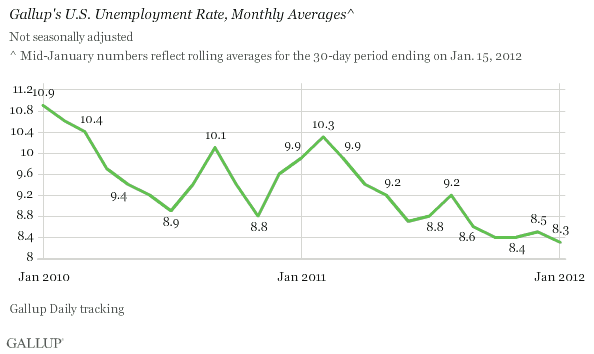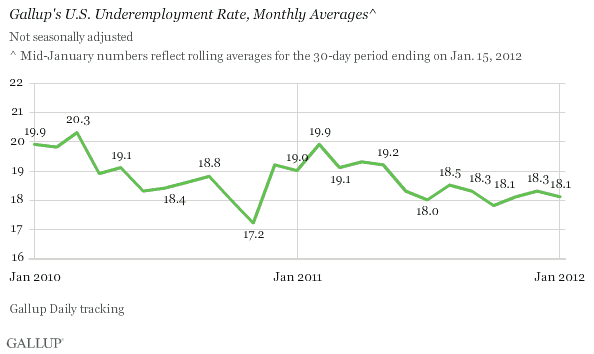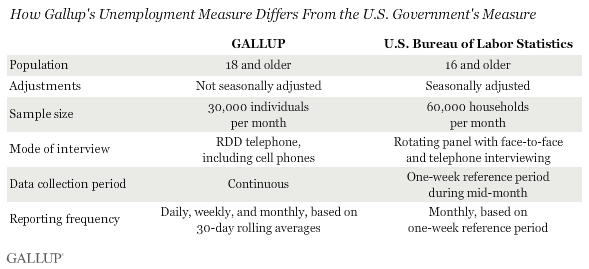PRINCETON, NJ -- U.S. unemployment, as measured by Gallup without seasonal adjustment, is 8.3% in mid-January -- a slight improvement from 8.5% in December, and down from 9.9% in January a year ago.

Gallup's mid-month unemployment reading, based on the 30 days ending Jan. 15, serves as a preliminary estimate of the U.S. government report, and suggests the Bureau of Labor Statistics will likely report on the first Friday of February that its seasonally adjusted unemployment rate declined once again in January.
The percentage of U.S. employees who are working part time but want full-time work is at 9.8% in mid-January, the same as in December. The mid-January reading is substantially higher than the 9.1% of January 2011.

Underemployment, a measure that combines the percentage of workers who are unemployed with the percentage working part time but wanting full-time work, is 18.1% in mid-January. This is a slight improvement from the 18.3% of December and down from the 19.0% of a year ago.

Looking Ahead to the Government's Unemployment Report
The U.S. government's January unemployment rate that it will report in early February will be based on mid-month conditions. Therefore, Gallup's mid-month unemployment reading, based on data collected through the 15th of the month, normally provides a good estimate of the government's unadjusted unemployment rate for the month. Because of employer layoffs after the holidays, unadjusted unemployment rates normally increase at this time of year, and the government seasonally adjusts for these layoffs. So it seems likely that the government will report another decline in its seasonally adjusted U.S. unemployment rate for January.
However, the government is revising its methodology beginning with the January 2012 report. As a result, the government notes, "household survey data for January 2012 will not be directly comparable with that for December 2011 or earlier periods." In turn, this makes estimating the government's unemployment rate for January even more difficult than usual.
Regardless of what the government reports, Gallup's unemployment and underemployment measures show modest improvement so far in January, and that is particularly positive news for job conditions at this time of year because the early part of the year is usually slow for hiring. This is good news for the overall U.S. economy. It is also a plus for the president's re-election efforts.
On the other hand, Gallup's underemployment measure also shows the percentage of Americans working part time but wanting full-time work is much higher than it was a year ago. If events in Europe or elsewhere force companies to pull back on hiring in the months ahead, many of these workers could quickly end up adding to the rolls of the unemployed.
Gallup's monitoring of the unemployment situation suggests cautious optimism, with a more positive outlook than was the case just a few months ago.
Editor's note: Beginning in January 2012, Gallup is reporting full-month unemployment and underemployment results instead of 30-day rolling averages as in the past. Mid-month estimates will continue to be reported on the basis of a 30-day rolling average. No changes or adjustments have been made to the Gallup unemployment and underemployment data themselves.

Gallup.com reports results from these indexes in daily, weekly, and monthly averages and in Gallup.com stories. Complete trend data are always available to view and export in the following charts:
Daily: Employment, Economic Confidence and Job Creation, Consumer Spending
Weekly: Employment, Economic Confidence, Job Creation, Consumer Spending
Read more about Gallup's economic measures.
View our economic release schedule.
Survey Methods
Gallup classifies American workers as underemployed if they are either unemployed or working part time but wanting full-time work. Gallup's results are not seasonally adjusted and are ahead of government reports by approximately two weeks.
Latest results are based on telephone interviews conducted as part of Gallup Daily tracking from Dec. 16, 2011, to Jan. 15, 2012, with a random sample of 18,516 adults, aged 18 and older, living in all 50 U.S. states and the District of Columbia, selected using random-digit-dial sampling. Monthly averages are based on more than 26,000 phone interviews conducted each calendar month with U.S. adults aged 18 and older in the workforce.
For results based on the total sample of working adults, one can say with 95% confidence that the maximum margin of sampling error is ±1 percentage point.
Interviews are conducted with respondents on landline telephones and cellular phones, with interviews conducted in Spanish for respondents who are primarily Spanish-speaking. Each sample includes a minimum quota of 400 cell phone respondents and 600 landline respondents per 1,000 national adults, with additional minimum quotas among landline respondents by region. Landline telephone numbers are chosen at random among listed telephone numbers. Cell phone numbers are selected using random-digit-dial methods. Landline respondents are chosen at random within each household on the basis of which member had the most recent birthday.
Samples are weighted by gender, age, race, Hispanic ethnicity, education, region, adults in the household, and phone status (cell phone only/landline only/both, cell phone mostly, and having an unlisted landline number). Demographic weighting targets are based on the March 2011 Current Population Survey figures for the aged 18 and older non-institutionalized population living in U.S. telephone households. All reported margins of sampling error include the computed design effects for weighting and sample design.
In addition to sampling error, question wording and practical difficulties in conducting surveys can introduce error or bias into the findings of public opinion polls.
For more details on Gallup's polling methodology, visit www.gallup.com.
